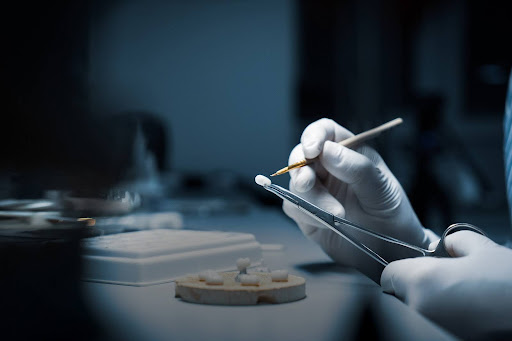When we think about a great smile, it’s usually the work of a dentist or orthodontist that comes to mind. However, there is an entire world behind those perfected smiles—the skilled, meticulous work of dental laboratory technicians. These unsung artisans work in tandem with dental professionals to create restorations like crowns, bridges, and dentures. Let’s take a closer look behind the scenes to understand the artistry, science, and skill that go into dental lab work.
The Art of Dental Lab Work
Creating a beautiful, natural-looking smile is as much an art as it is a science. Dental lab technicians are highly trained artisans who meticulously design and craft each dental restoration to fit seamlessly into a patient’s mouth. Here’s how they achieve this balance:
- Precision and Detail: Every crown, bridge, or denture must match the natural shape, size, and color of the surrounding teeth. This process requires an intense level of precision, and often, lab technicians become experts in sculpting, shaping, and shading. They consider aspects like translucency and shading, matching restorations to existing teeth in ways that make it nearly impossible to tell the difference between natural and artificial.
- Creative Problem-Solving: Each patient’s dental structure is unique, so no two cases are ever truly alike. Lab technicians must creatively address these differences, whether it’s replicating the exact hue of a slightly stained tooth or customizing a dental bridge to fit an unusually shaped bite. This adaptability demands not only technical skills but also creativity.
- Aesthetic Sensibility: Dental lab work doesn’t just involve clinical standards but also an artistic eye. Knowing how to create something that looks natural involves understanding subtle details, like tooth shape, size, and orientation, that influence how a patient’s smile will look.
The Science of Dental Lab Work
Behind the artistry lies a foundation in science that is essential for producing restorations that are functional, durable, and biocompatible.
- Advanced Materials: Dental laboratories work with an array of specialized materials, from ceramics and porcelain to zirconia and composite resins. Each material has specific properties that make it suitable for different types of restorations. For example, zirconia is incredibly strong, making it a preferred choice for crowns on back teeth, while porcelain is often used for visible restorations due to its lifelike appearance.
- Cutting-Edge Technology: The dental lab field has seen revolutionary changes in recent years thanks to advances in digital technology. Techniques like CAD/CAM (Computer-Aided Design/Computer-Aided Manufacturing) allow technicians to create digital impressions and develop more precise molds and designs. Additionally, 3D printing technology has enabled labs to create prototypes and even final products with unprecedented accuracy and efficiency.
- Dental Anatomy Knowledge: Understanding how teeth function within the larger framework of the jaw and skull is crucial. Lab technicians study dental anatomy to ensure that the restorations they create are not only aesthetically pleasing but also functional. Misalignments or incorrectly designed restorations can cause long-term dental problems, so technicians must make adjustments to support proper bite and jaw function.
Collaboration Between Dentists and Dental Labs
Successful dental restoration is a team effort that hinges on the relationship between dentists and lab technicians. Both parties rely on each other’s expertise to deliver the best results for patients.
- Effective Communication: To ensure that lab technicians can produce the best possible result, dentists provide detailed impressions, photographs, and often, digital scans of the patient’s teeth. Any small detail missed can affect the final product, so clear communication is vital.
- Customized Solutions: Dentists and lab technicians frequently consult each other to develop tailored solutions that meet the unique needs of each patient. Whether a dentist seeks a specific shade for a crown or needs a bridge adjusted to accommodate bite issues, collaboration ensures that the final product is both functional and visually appealing.
- Mutual Trust: A great dental outcome is only possible when there is mutual trust between the dentist and the lab technician. Each relies on the other to provide the necessary input and expertise. This teamwork is the backbone of high-quality dental restorations.
The Patient’s Experience and the Impact of Quality Dental Lab Work
When dental lab work is done right, it has a transformative effect on the patient’s life. Here’s how quality craftsmanship impacts patients:
- A Boost in Confidence: Dental restorations do more than just replace missing or damaged teeth—they restore a patient’s self-esteem. A well-crafted crown or bridge can improve the appearance of a patient’s smile, making them feel more confident in social and professional interactions.
- Functional Improvements: Dental lab work isn’t just about aesthetics; it plays a critical role in ensuring that the patient can chew, speak, and use their teeth comfortably. Properly fitted dental restorations improve daily functionality, giving patients the freedom to enjoy life without worrying about discomfort or embarrassment.
- Long-Term Health: When crafted properly, dental restorations contribute to a patient’s long-term dental health. Correctly aligned and shaped prosthetics reduce strain on surrounding teeth, help prevent shifting, and maintain the overall integrity of the patient’s oral structure.
The Future of Dental Lab Work: Innovation and Excellence
As technology continues to advance, the field of dental lab work will only become more sophisticated. The integration of artificial intelligence, enhanced digital scanning, and even bio-compatible materials like bioceramics promise a future where dental restorations are not only more accurate but also more adaptable to each patient’s needs.
The art and science of dental lab work might remain “behind the smile,” but the impact it has is profound and transformative. With each meticulously crafted restoration, dental lab technicians bring together art, science, and compassion to improve the lives of their patients. In an era where every detail matters, dental lab professionals ensure that every smile is both functional and beautiful—truly a remarkable achievement that deserves to be celebrated.

